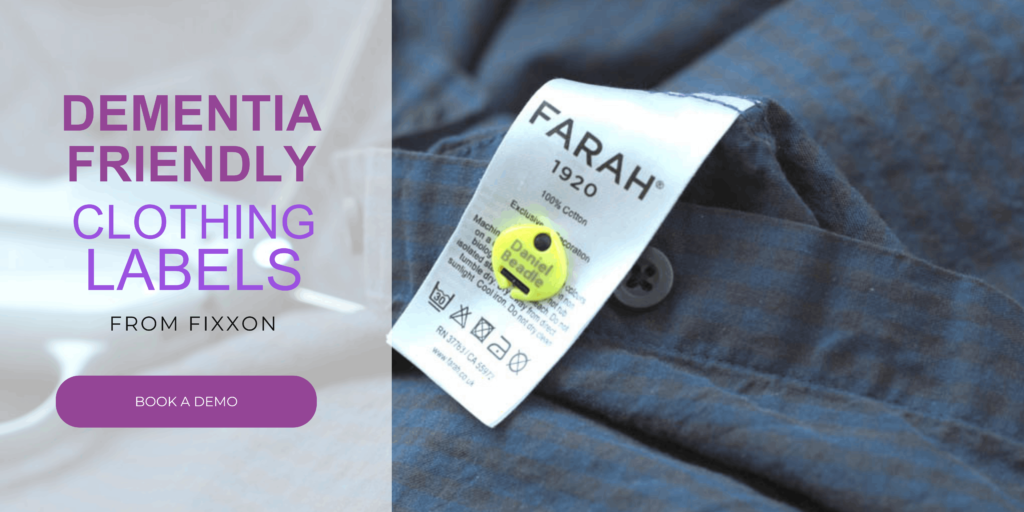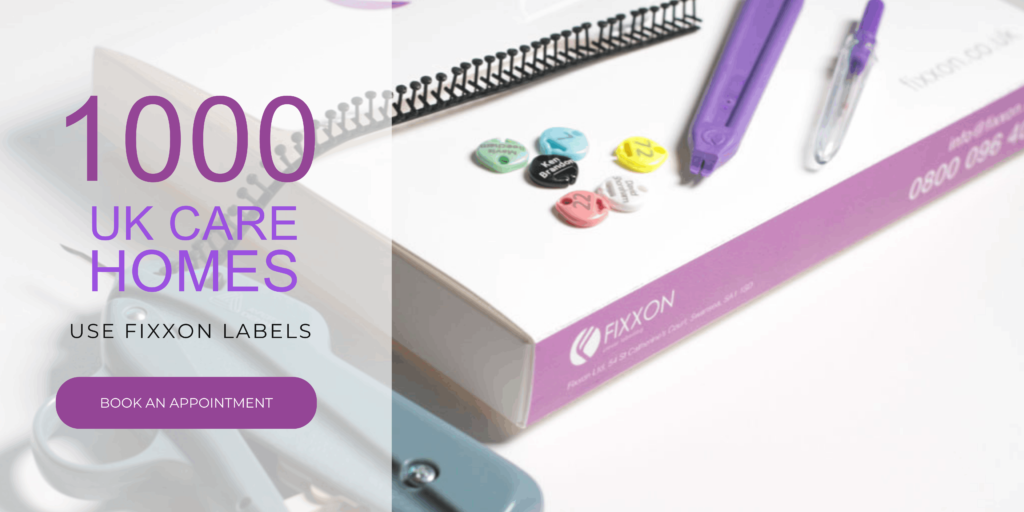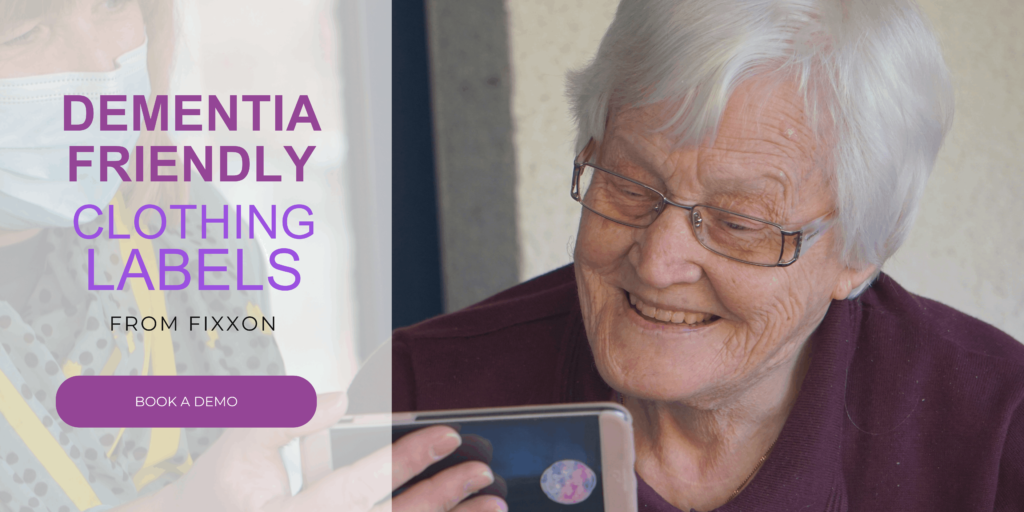How do you create a dementia-friendly care home? When you’re a care home manager, this question is likely at the top of your list to create a safe space for those residents living with dementia in your care.
By doing things like careful planning of your care home layout, using the right safety features and swapping to tools that can support your day to day work, you can create a space that reduces anxiety.
In this article, we’ll look at how you can help a person with dementia by providing them with the right environment to thrive. We’ll also show how making simple tool swaps, like using an effective labelling system, can support your daily dementia care work.

Why is a dementia-friendly environment important for care homes?
If you work at a specialist dementia care home, you should already be familiar with the main objectives of your surroundings. As a basis, you should be aiming to create an environment that:
- Takes away confusion and disorientation
- Reduces stress
- Helps give a better routine and is familiar
- Leaves those in your care with a sense of security
- Helps your residents to remain social
- Is calming and doesn’t overload the senses
Even the smallest changes to the care home environment can make a big difference to making those in your care feel more comfortable.

What specific changes can you make to create a dementia-friendly space?
1. Safety and Security
Safety should be your top dementia support priority, and you should focus on the following:
- Outdoor space: You could provide safe and enclosed gardens that give your residents a chance to get some sun and nature. By having the gardens enclosed – preferably with natural planting like hedges – those in your care can relax without the possibility of getting confused and wandering. The garden could feature things to stimulate the senses like water features and wind chimes, because these can help to draw attention and calm any anxiety.
- Clear signage: Your care home should have dementia-friendly signage that’s made of high-contrast colours and simple words. This makes it easier for those in your care to see and understand.
- Lighting: The care home should have bright and even lighting that lights the way forward without being too much and overstimulating. Each light should have easy to access switches that are possibly illuminated.
- Handrails: Your care home should have handrails to grab in all of the hallways so your residents can more easily get around without the risk of falling over.
- Emergency response systems: You should give each resident a wearable call button so they can call for help if they ever need it.
- Dementia-friendly clocks: Large, easy-to-read clocks with clear numbers can help your residents to stay aware of the time in a way that doesn’t confuse them.
2. Familiarity and Routine
By making familiar surroundings, you can put your residents at ease, especially when they first move into a care home. Making the following small changes can make a big difference in creating a comfortable dementia residential care home:
- Use familiar objects: Placing objects from your residents’ childhood that bring back a sense of nostalgia in common areas can help your residents to remember where they need to go.
- Stick to the same routines: Make sure your care home does the same things at roughly the same time each day because this helps to reduce anxiety.
3. Social Interaction
A big part of dementia care is making sure people remain in contact with their friends and family. So, your care home should try the following methods to create a dementia-friendly community:
- Create communal spaces: Give your residents somewhere to play, chat and have conversations with each other.
- Have rooms for different things: Create different spaces for different dementia-friendly activities. For example, the room that does music therapy is not the best place for an arts and crafts club due to distraction – so find a way to keep them separate.
- Make dining areas: Your residents need a more well-lit and formal space to have dinner, which is not the best way to layout a social space. So you should keep dining, socialising and living areas separate.
- Leave enough quiet areas: Your care home should also offer quiet areas where your residents can relax in a calm, peaceful environment. These areas are essential for reducing anxiety and providing a retreat from loud sounds or bright lights that could be overwhelming.
4. Supporting Independence
Another huge task you have is to keep your residents as independent as possible for as long as possible. Simple design choices can go a long way to helping you achieve this:
- Bathrooms: Design bathrooms to be accessible. This should include easy-to-use taps and showers with grab bars, allowing your residents to take better personal care in a simpler and safer way.
- Pathways: Your care home’s hallways and pathways should be clear and unobstructed. Don’t clutter them up with furniture, cleaning supplies or objects. They should allow your residents to move freely and safely.
- Adaptive equipment: Provide easy-to-use furniture and tools that help your residents carry out familiar tasks with confidence and autonomy.
5. Sensory Stimulation
The big question is, can the design of the care home environment reduce anxiety and agitation? The answer is yes; a dementia-friendly environment should be calming for your residents in the following ways:
- Soothing lighting: Your care home’s lighting should be soft and natural in feel but always with a focus on improving visibility.
- Calming sounds: You could consider playing light background music (think Classical) or natural sounds like birds chirping. These can reduce anxiety. But be sure to keep it low volume as loud noises can be unsettling.
- Tactile: Your care home should use soft fabrics on its furniture where possible. While you’ll likely need to keep chairs wipe clean, adding blankets and pillows can be a great way to add comfort.
- Aromatherapy: By using scents known to induce a feeling of calm, like lavender or rosemary, you can help your residents to relax and feel at ease.
- Reflections: Mirrors or reflective surfaces can sometimes cause distress for people with dementia, so keep an eye how your residents react and remove them if you need to.

Top tip: Use a dementia-friendly environment checklist
Use a dementia-friendly environment checklist to ensure your care home meets the best standards for residents with dementia.
Access the dementia care home checklist for practical design tips and guidance from the Alzheimer Society here.
Practical Considerations for Designing Dementia-Friendly Spaces
When creating a dementia-friendly environment, getting the balance right with decoration is key to creating a space your residents can feel at home in. Here are some dementia-friendly care home decorating ideas:
- Create simple layouts: Keep spaces open, and lay furniture out in such a way that isn’t likely to block access.
- Use dementia-friendly colours that contrast: Use different colours for doors, walls, and furniture to make important objects more visible. For example, if you paint a door frame a different colour to the surrounding wall, it can make it easier for your residents to see where to go.
- Avoid patterned or shiny surfaces: These can cause confusion, making it difficult for residents to judge distances or see objects clearly. Stick to plain, gentle colours for walls and furniture.
- Use colour-coded labelling: Use labels for wardrobes, drawers, and personal belongings. You can use Fixxon’s colour-coded name labels on your residents’ clothing to make it easy for them to tell their belongings from someone else’s.
How do dementia-friendly labels help with daily living?
Fixxon’s labelling system provides a reusable, practical, and dignified way to label garments in dementia care homes:
- Prevents Clothing Loss
Traditional labelling methods like marker pens, iron-ons, and sew-ins often wear off, especially on dark or delicate fabrics. After being washed many times, these methods tend to fade, peel off, or become hard to read.
A better choice is Fixxon’s laser-etched labels. Labels that are designed to be permanent and readable across all types of clothing. This helps reduce your chances of mix-ups or lost clothing, which is one of the biggest challenges for laundry in care homes. - Durable
Our labels are designed for care home laundry. They can withstand high-temperature wash cycles and any harsh chemicals without fading or falling off. - Quick and Efficient
The Fixxon clothing labels are fast to apply and remove with the specially made gun, which makes your clothes labelling much quicker. - Colour-Coded for Organisation
With six colour options, our labels allow for you to colour-code clothing by any way you choose – although many care homes organise by ward or resident. By using a simple system, you can sort quicker and spend less time on doing laundry. - Promotes Independence and Dignity
By offering clear and durable laser-etched names or numbers, our Fixxon labels helps your residents to keep their dignity by making sure they always receive their own clothes. The families of those in your care also gain peace of mind, knowing their loved ones’ belongings are properly cared for.

Ready to make your care home more dementia-friendly?
A dementia-friendly care home is designed to enhance the lives of its residents through safety, independence, and personalised care.
Fixxon’s labelling system is a simple but effective way to support these goals, helping create a more organised, comfortable environment.
Book a demo with Fixxon today to learn more about how our labelling system can support your care environment.







